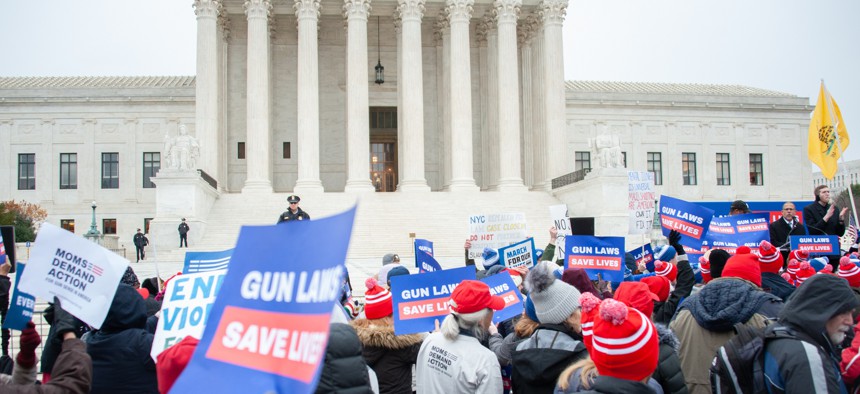Earlier this week, the Supreme Court announced that it would hear New York State Rifle and Pistol Association v. Corlett. This is bad news for proponents of gun control in New York. The case is a challenge to a strictly enforced state law that requires a showing of “proper cause” before people can obtain a license to carry a firearm outside of the home. Given the sharp turn to the right the Supreme Court has taken, thanks to Donald Trump being able to get more Supreme Court justices confirmed in a single term than Barack Obama was in two, it is highly unlikely that the restriction will survive.
While the Second Amendment to the U.S. Constitution has often been perceived as the major barrier to passing gun control measures in the United States, this has generally not really been true. For most of American history, the Supreme Court did not recognize an individual right to bear arms at all. (Former Chief Justice Warren Burger, whom Republican President Richard Nixon nominated because of his reputation as a “law and order” judge, called the idea that the Constitution protects an individual right to bear arms a “fraud.”) But even after the Supreme Court created an individual right to bear arms in the 2008 case D.C. v. Heller, the state retained a wide latitude to regulate firearms. “[T]he right secured by the Second Amendment is not unlimited,” declared Justice Antonin Scalia in his opinion for the Court, and “nothing in our opinion should be taken to cast doubt on longstanding prohibitions on the possession of firearms by felons and the mentally ill, or laws forbidding the carrying of firearms in sensitive places such as schools and government buildings, or laws imposing conditions and qualifications on the commercial sale of arms.” Scalia also observed that the government could ban “dangerous and unusual” firearms.
Both Heller and the follow-up case McDonald v. Chicago (which held that the individual right to bear arms constrained the states as well as the federal government) said only that laws preventing people from having an operative handgun for self-defense in their homes were illegal. Nothing in either case suggested that New York’s strict licensing requirement for taking handguns outside the home was unconstitutional.
Until now, then, the primary barrier to passing gun control legislation has been political, not legal. The federal government and the overwhelming majority of state and local jurisdictions have passed less stringent gun control regulations than the Court permitted in Heller. Only laws that prevented keeping guns in one’s home were at-risk of being overturned. But this is about to change.
The reason for the coming judicial war on gun control, as Vox’s Ian Millhiser observes, was revealed in the memoir Justice John Paul Stevens released shortly before his death two years ago. According to Stevens, the qualifying and moderating language in Scalia’s opinion was mostly added at the insistence of Justice Anthony Kennedy, the most moderate member of the five-justice conservative majority. But Kennedy, a Republican appointee, decided to retire strategically in 2018 while Trump was in office. He was replaced by his former clerk Brett Kavanaugh, a justice with a quite radical anti-gun control record. The Second Amendment is one of the many issues where Kavanaugh’s confirmation figures to move the Court to the right.
Still, the holding period the Court has been in with respect to gun control persisted even after Kavanaugh’s confirmation. The Court repeatedly refused to provide the four votes necessary to hear gun control appeals, presumably because the Court’s four most conservative judges were not confident that the Court’s then-median vote, Chief Justice John Roberts, would be willing to push the Court to the right on Second Amendment issues.
The death of Justice Ruth Bader Ginsburg and the rapid Senate confirmation of Justice Amy Coney Barrett, however, makes Roberts’s vote superfluous. Barrett, like Kavanaugh, has a notably conservative record on the Second Amendment. The decision of the Court to finally grant certiorari in a major gun control case suggests that the Court’s conservatives believe they have the votes to overturn gun control measures generally opposed by Republicans, and this assumption is well-founded in the public record of Trump’s Supreme Court nominees.
It is unclear exactly how far the new Supreme Court majority will go in expanding Second Amendment rights. But the most vulnerable laws are atypically restrictive outliers in Democratic-controlled states. This is very bad news for New York’s licensing requirement. It is almost inconceivable that the regulation will be upheld by this Supreme Court. And other regulations – such as the bans on assault weapons passed at both the state level and by municipal governments in New York City, Albany, Rochester and Buffalo – could also be highly vulnerable.
With New York City dealing with a homicide rate that sharply spiked in 2020 for reasons that are not fully understood, more people carrying firearms on city streets are the last thing the state needs. But, thanks to the contingencies of the Supreme Court appointment process, it is what the state and its residents are almost certainly going to get.
NEXT STORY: The pandemic’s affordable housing opportunity


